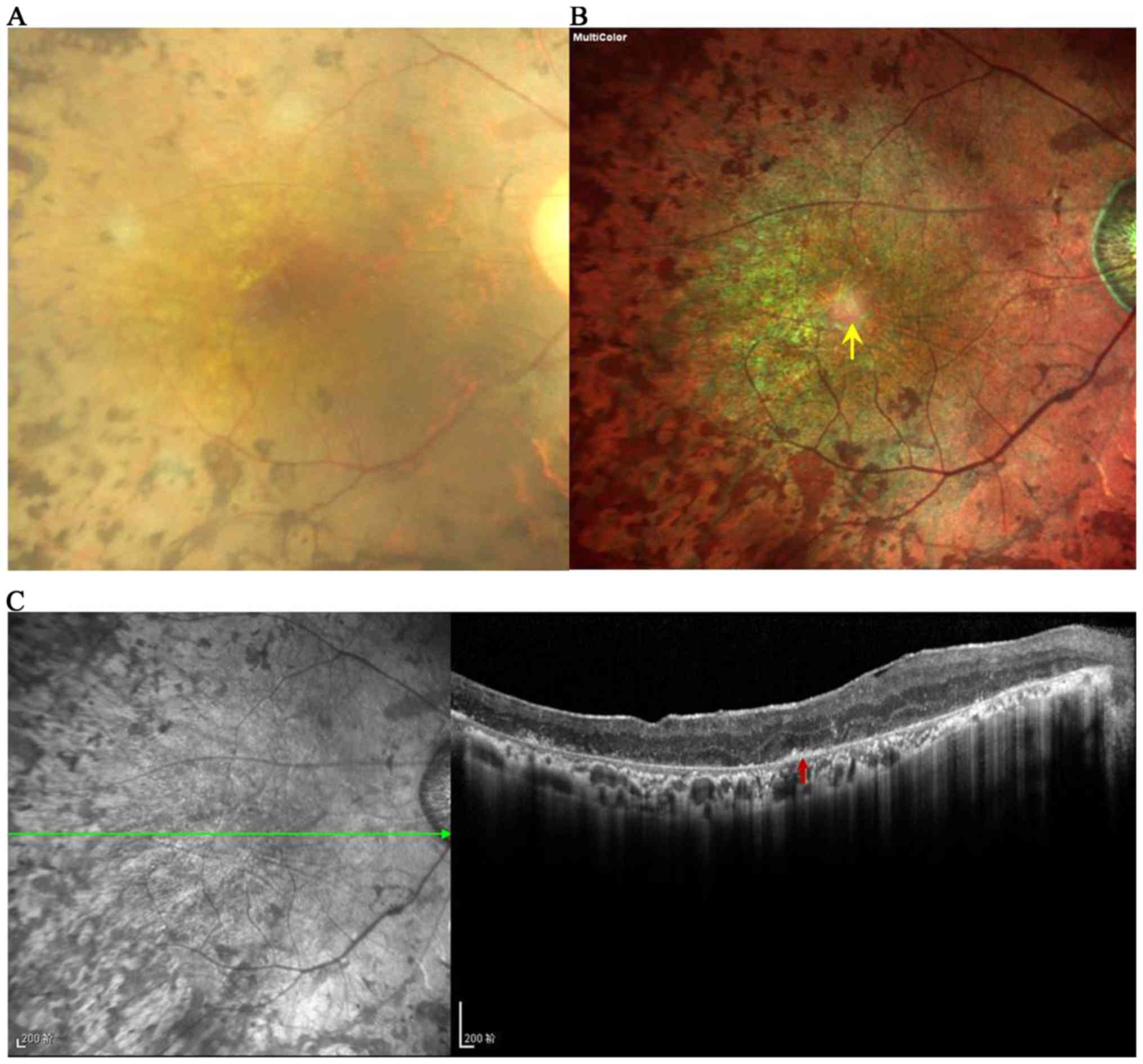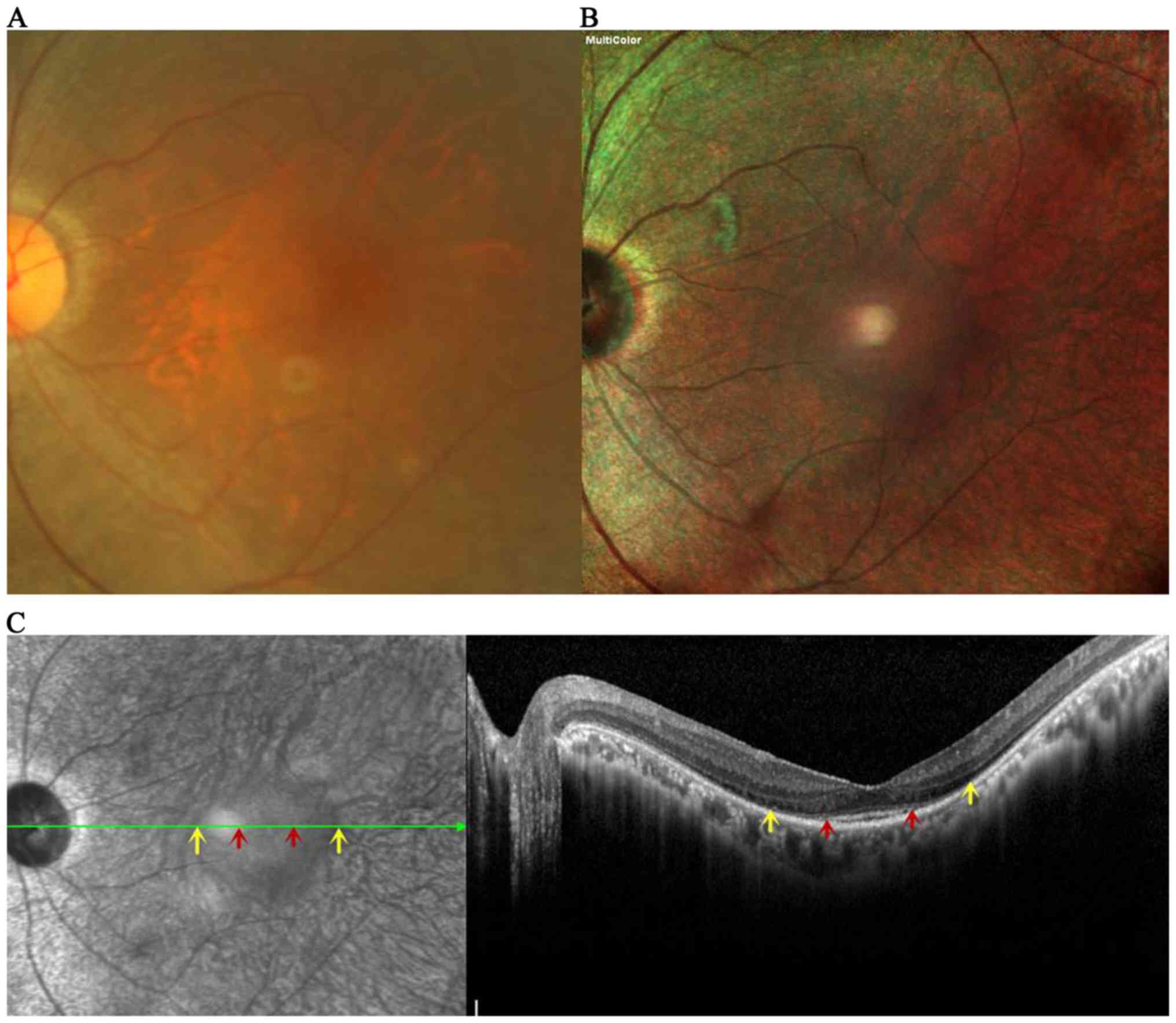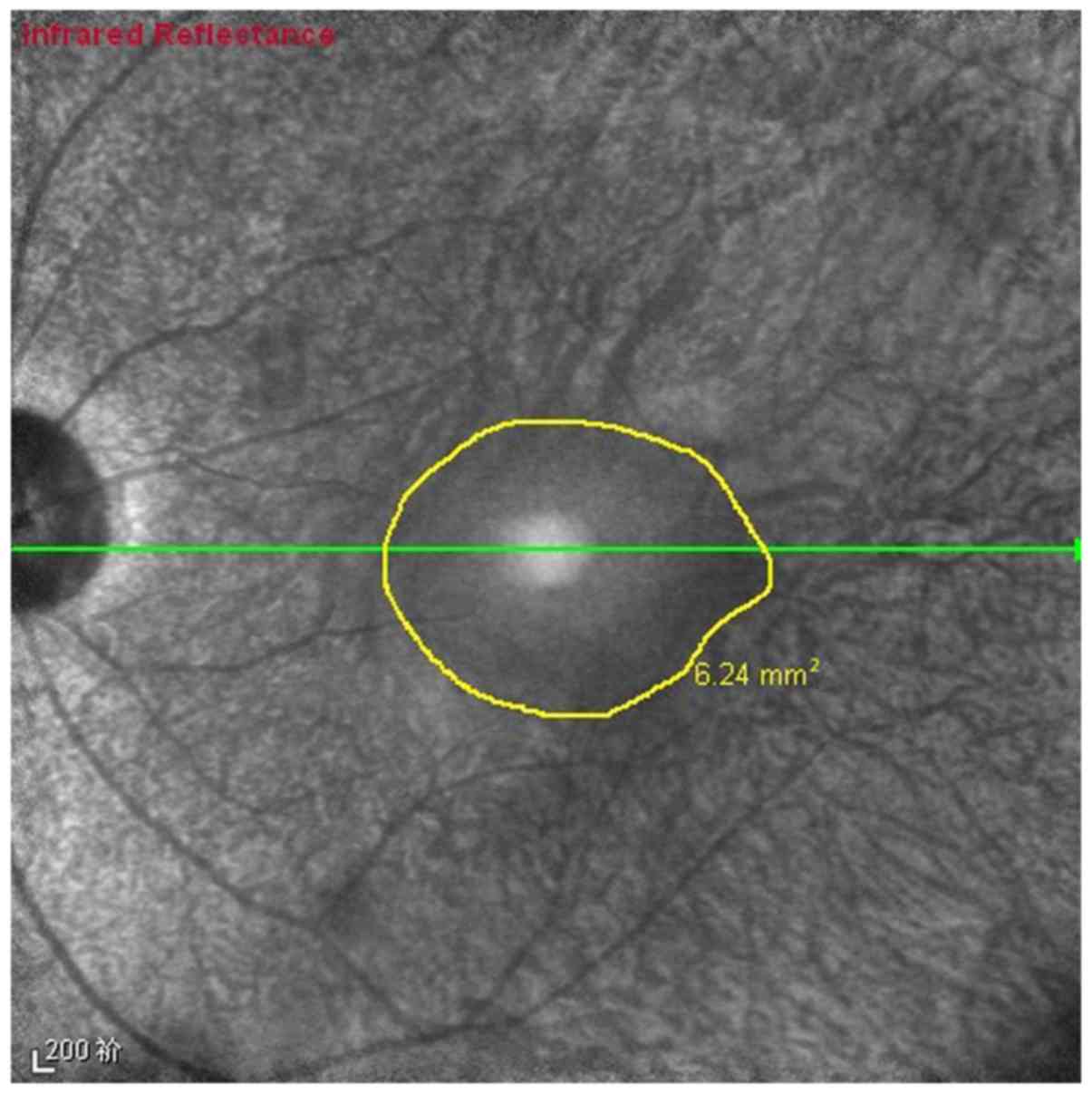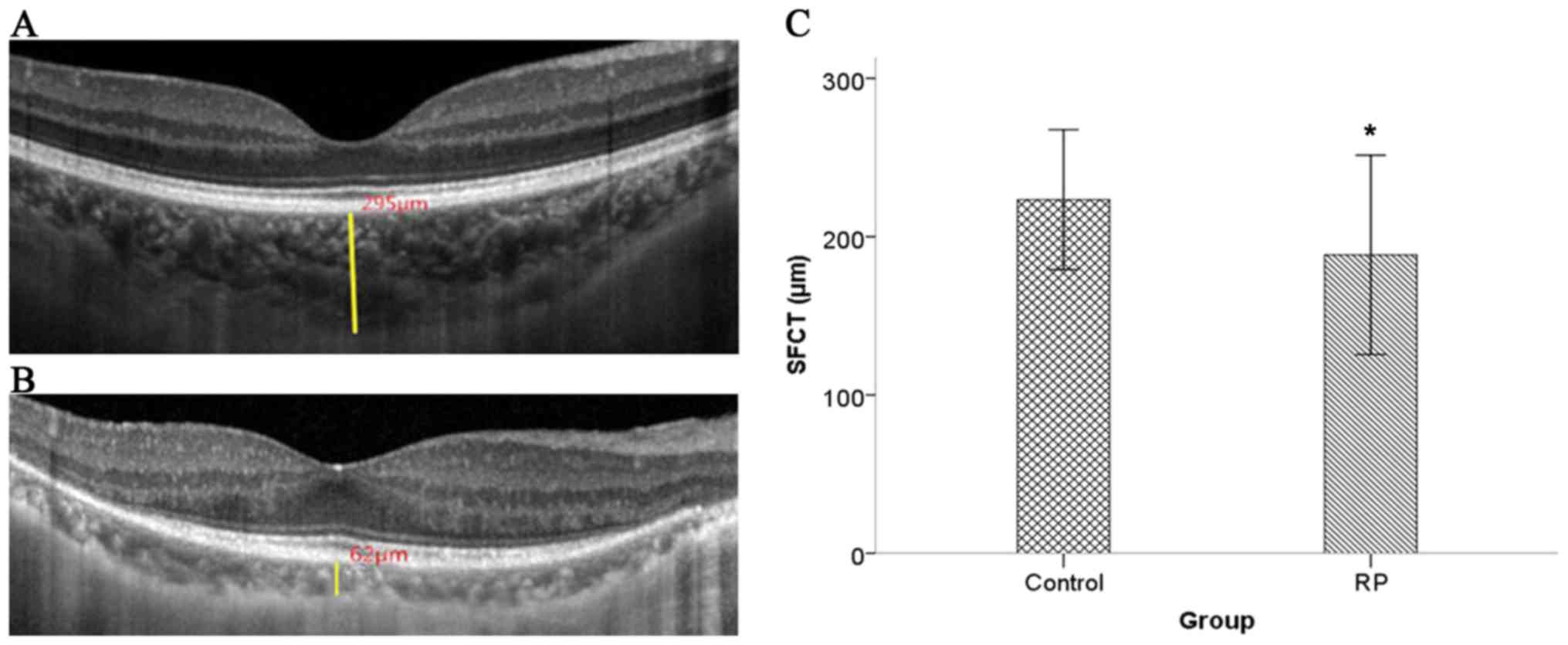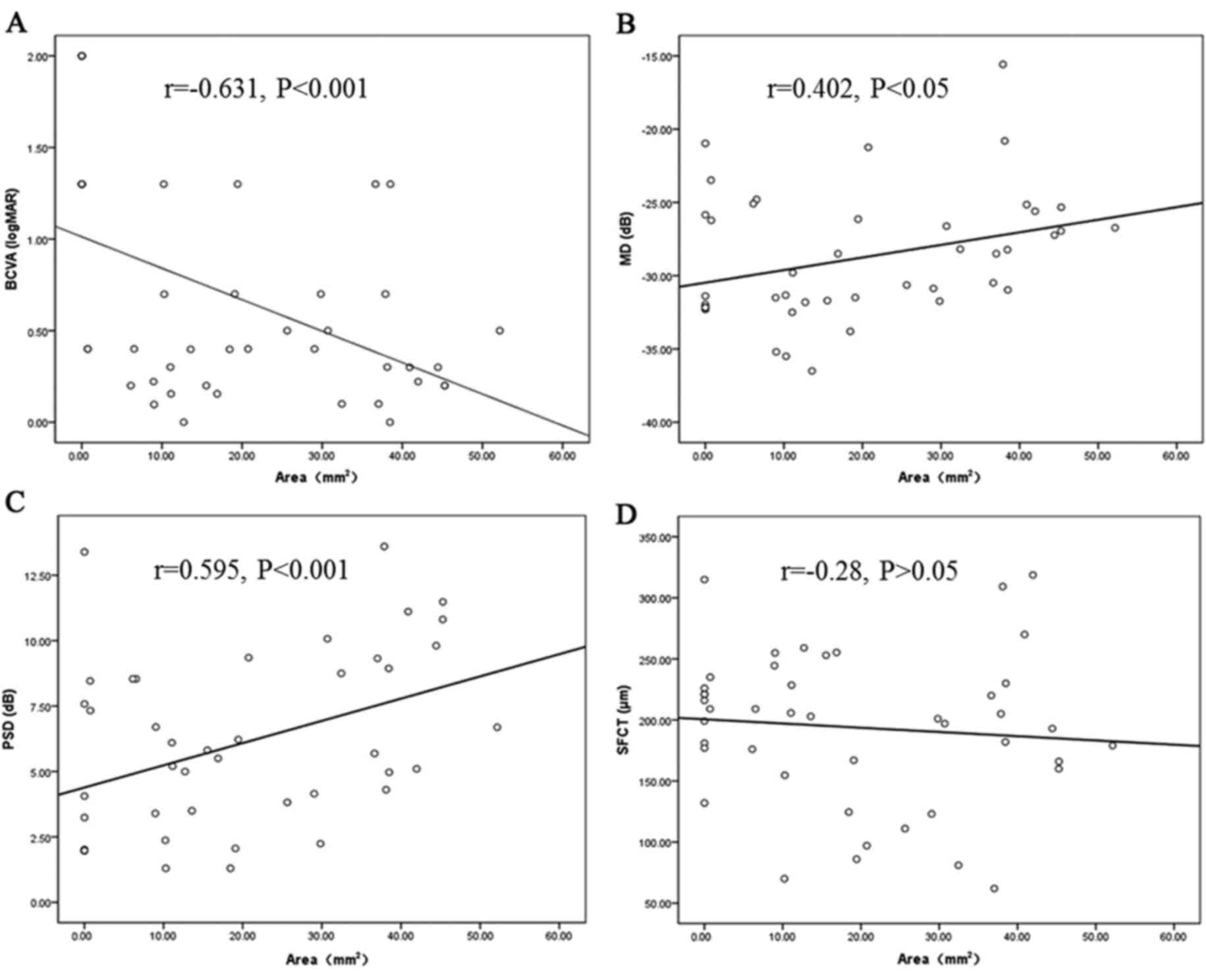|
1
|
Mrejen S, Audo I, Bonnel S and Sahel JA:
Retinitis pigmentosa and other dystrophies. Dev Ophthalmol.
58:191–201. 2017. View Article : Google Scholar : PubMed/NCBI
|
|
2
|
Hartong DT, Berson EL and Dryja TP:
Retinitis pigmentosa. Lancet. 368:1795–1809. 2006. View Article : Google Scholar : PubMed/NCBI
|
|
3
|
Berson EL: Long-term visual prognoses in
patients with retinitis pigmentosa: The ludwig von sallmann
lecture. Exp Eye Res. 85:7–14. 2007. View Article : Google Scholar : PubMed/NCBI
|
|
4
|
Flynn MF, Fishman GA, Anderson RJ and
Roberts DK: Retrospective longitudinal study of visual acuity
change in patients with retinitis pigmentosa. Retina. 21:639–646.
2001. View Article : Google Scholar : PubMed/NCBI
|
|
5
|
Aizawa S, Mitamura Y, Hagiwara A, Sugawara
T and Yamamoto S: Changes of fundus autofluorescence, photoreceptor
inner and outer segment junction line, and visual function in
patients with retinitis pigmentosa. Clin Exp Ophthalmol.
38:597–604. 2010. View Article : Google Scholar : PubMed/NCBI
|
|
6
|
Drexler W, Sattmann H, Hermann B, Ko TH,
Stur M, Unterhuber A, Scholda C, Findl O, Wirtitsch M, Fujimoto JG
and Fercher AF: Enhanced visualization of macular pathology with
the use of ultrahigh-resolution optical coherence tomography. Arch.
Ophthalmol. 121:695–706. 2003.
|
|
7
|
Sun LW, Johnson RD, Langlo CS, Cooper RF,
Razeen MM, Russillo MC, Dubra A, Connor TB Jr, Han DP, Pennesi ME,
et al: Assessing photoreceptor structure in retinitis pigmentosa
and usher syndrome. Invest Ophthalmol Vis Sci. 57:2428–2442. 2016.
View Article : Google Scholar : PubMed/NCBI
|
|
8
|
Liu G, Li H, Liu X, Xu D and Wang F:
Structural analysis of retinal photoreceptor ellipsoid zone and
postreceptor retinal layer associated with visual acuity in
patients with retinitis pigmentosa by ganglion cell analysis
combined with OCT imaging. Medicine (Baltimore). 95:e57852016.
View Article : Google Scholar : PubMed/NCBI
|
|
9
|
Fischer MD, Fleischhauer JC, Gillies MC,
Sutter FK, Helbig H and Barthelmes D: A new method to monitor
visual field defects caused by photoreceptor degeneration by
quantitative optical coherence tomography. Invest Ophthalmol Vis
Sci. 49:3617–3621. 2008. View Article : Google Scholar : PubMed/NCBI
|
|
10
|
Chan TCY, Lam SC, Mohamed S and Wong RLM:
Survival analysis of visual improvement after cataract surgery in
advanced retinitis pigmentosa. Eye (Lond). Aug 4–2017.(Epub ahead
of print). doi: 10.1038/eye.2017.164. View Article : Google Scholar
|
|
11
|
Ikeda Y, Yoshida N, Murakami Y, Nakatake
S, Notomi S, Hisatomi T, Enaida H and Ishibashi T: Long-term
surgical outcomes of epiretinal membrane in patients with
retinitis. Sci Rep. 5:130782015. View Article : Google Scholar : PubMed/NCBI
|
|
12
|
Pang CE and Freund KB: Ghost maculopathy:
An artifact on near-infrared reflectance and multicolor imaging
masquerading as chorioretinal pathology. Am J Ophthalmol.
158:171–178. 2014. View Article : Google Scholar : PubMed/NCBI
|
|
13
|
Wen Y, Klein M, Hood DC and Birch DG:
Relationships among multifocal electroretinogram amplitude, visual
field sensitivity, and SD-OCT receptor layer thicknesses in
patients with retinitis pigmentosa. Invest Ophthalmol Vis Sci.
53:833–840. 2012. View Article : Google Scholar : PubMed/NCBI
|
|
14
|
Sergott RC: Retinal segmentation using
multicolor laser imaging. J Neuroophthalmol. 34 Suppl:S24–S28.
2014. View Article : Google Scholar : PubMed/NCBI
|
|
15
|
Zeng J, Li J, Liu R, Chen X, Pan J, Tang S
and Ding X: Choroidal thickness in both eyes of patients with
unilateral idiopathic macular hole. Ophthalmology. 119:2328–2333.
2012. View Article : Google Scholar : PubMed/NCBI
|
|
16
|
Lemke S, Cockerham GC, Glynn-Milley C, Lin
R and Cockerham KP: Automated perimetry and visual dysfunction in
blast-related traumatic brain injury. Ophthalmology. 123:415–424.
2015. View Article : Google Scholar : PubMed/NCBI
|
|
17
|
Andjelic S, Drašlar K, Hvala A and Hawlina
M: Anterior lens epithelium in cataract patients with retinitis
pigmentosa - scanning and transmission electron microscopy study.
Acta Ophthalmol. 95:e212–e220. 2017. View Article : Google Scholar : PubMed/NCBI
|
|
18
|
Fujiwara K, Ikeda Y, Murakami Y, Nakatake
S, Tachibana T, Yoshida N, Nakao S, Hisatomi T, Yoshida S,
Yoshitomi T, et al: Association between aqueous flare and
epiretinal membrane in retinitis pigmentosa. Invest Ophthalmol Vis
Sci. 57:4282–4286. 2016. View Article : Google Scholar : PubMed/NCBI
|
|
19
|
Strong S, Liew G and Michaelides M:
Retinitis pigmentosa-associated cystoid macular oedema:
Pathogenesis and avenues of intervention. Br J Ophthalmol.
101:31–37. 2017. View Article : Google Scholar : PubMed/NCBI
|
|
20
|
Semoun O, Guigui B, Tick S, Coscas G,
Soubrane G and Souied EH: Infrared features of classic choroidal
neovascularisation in exudative age-related macular degeneration.
Br J Ophthalmol. 93:182–185. 2009. View Article : Google Scholar : PubMed/NCBI
|
|
21
|
Ben Moussa N, Georges A, Capuano V, Merle
B, Souied EH and Querques G: MultiColor imaging in the evaluation
of geographic atrophy due to age-related macular degeneration. Br J
Ophthalmol. 99:842–847. 2015. View Article : Google Scholar : PubMed/NCBI
|
|
22
|
Yoon CK and Yu HG: The structure-function
relationship between macular morphology and visual function
analyzed by optical coherence tomography in retinitis pigmentosa. J
Ophthalmol. 2013:8214602013. View Article : Google Scholar : PubMed/NCBI
|
|
23
|
Smith TB, Parker M, Steinkamp PN, Weleber
RG, Smith N and Wilson DJ: VPA Clinical Trial Study Group; EZ
Working Group: Structure-function modeling of optical coherence
tomography and standard automated perimetry in the retina of
patients with autosomal dominant retinitis pigmentosa. PLoS One.
11:e01480222016. View Article : Google Scholar : PubMed/NCBI
|
|
24
|
Fischer MD, Fleischhauer JC, Gillies MC,
Sutter FK, Helbig H and Barthelmes D: A new method to monitor
visual field defects caused by photoreceptor degeneration by
quantitative optical coherence tomography. Invest Ophthalmol Vis
Sci. 49:3617–3621. 2008. View Article : Google Scholar : PubMed/NCBI
|
|
25
|
Wakabayashi T, Sawa M, Gomi F and
Tsujikawa M: Correlation of fundus autofluorescence with
photoreceptor morphology and functional changes in eyes with
retinitis pigmentosa. Acta Ophthalmol. 88:e177–e183. 2010.
View Article : Google Scholar : PubMed/NCBI
|
|
26
|
Wen Y and Birch DG: Outer segment
thickness predicts visual field response to QLT091001 in patients
with RPE65 or LRAT mutations. Transl Vis Sci Technol. 4:82015.
View Article : Google Scholar : PubMed/NCBI
|
|
27
|
Rao HL, Raveendran S, James V, Dasari S,
Palakurthy M, Reddy HB, Pradhan ZS, Rao DA, Puttaiah NK and Devi S:
Comparing the performance of compass perimetry with humphrey field
analyzer in eyes with glaucoma. J Glaucoma. 26:292–297. 2017.
View Article : Google Scholar : PubMed/NCBI
|
|
28
|
Miyata M, Hata M, Ooto S, Ogino K, Gotoh
N, Morooka S, Hasegawa T, Hirashima T, Sugahara M, Kuroda Y, et al:
Choroidal and retinal atrophy of bietti crystalline dystrophy
patients with CYP4V2 mutations compared to retinitis pigmentosa
patients with eys mutations. Retina. 37:1193–1202. 2017. View Article : Google Scholar : PubMed/NCBI
|
|
29
|
Saint-Geniez M, Kurihara T, Sekiyama E,
Maldonado AE and D'Amore PA: An essential role for RPE-derived
soluble VEGF in the maintenance of the choriocapillaris. Proc Natl
Acad Sci USA. 106:pp. 18751–18756. 2009, View Article : Google Scholar : PubMed/NCBI
|
|
30
|
Ohlmann A, Scholz M, Koch M and Tamm ER:
Epithelial-mesenchymal transition of the retinal pigment epithelium
causes choriocapillaris atrophy. Histochem Cell Biol. 146:769–780.
2016. View Article : Google Scholar : PubMed/NCBI
|
|
31
|
Adhi M, Regatieri CV, Branchini LA, Zhang
JY, Alwassia AA and Duker JS: Analysis of the morphology and
vascular layers of the choroid in retinitis pigmentosa using
spectral-domain OCT. Ophthalmic Surg Lasers Imaging Retina.
44:252–259. 2013. View Article : Google Scholar : PubMed/NCBI
|



